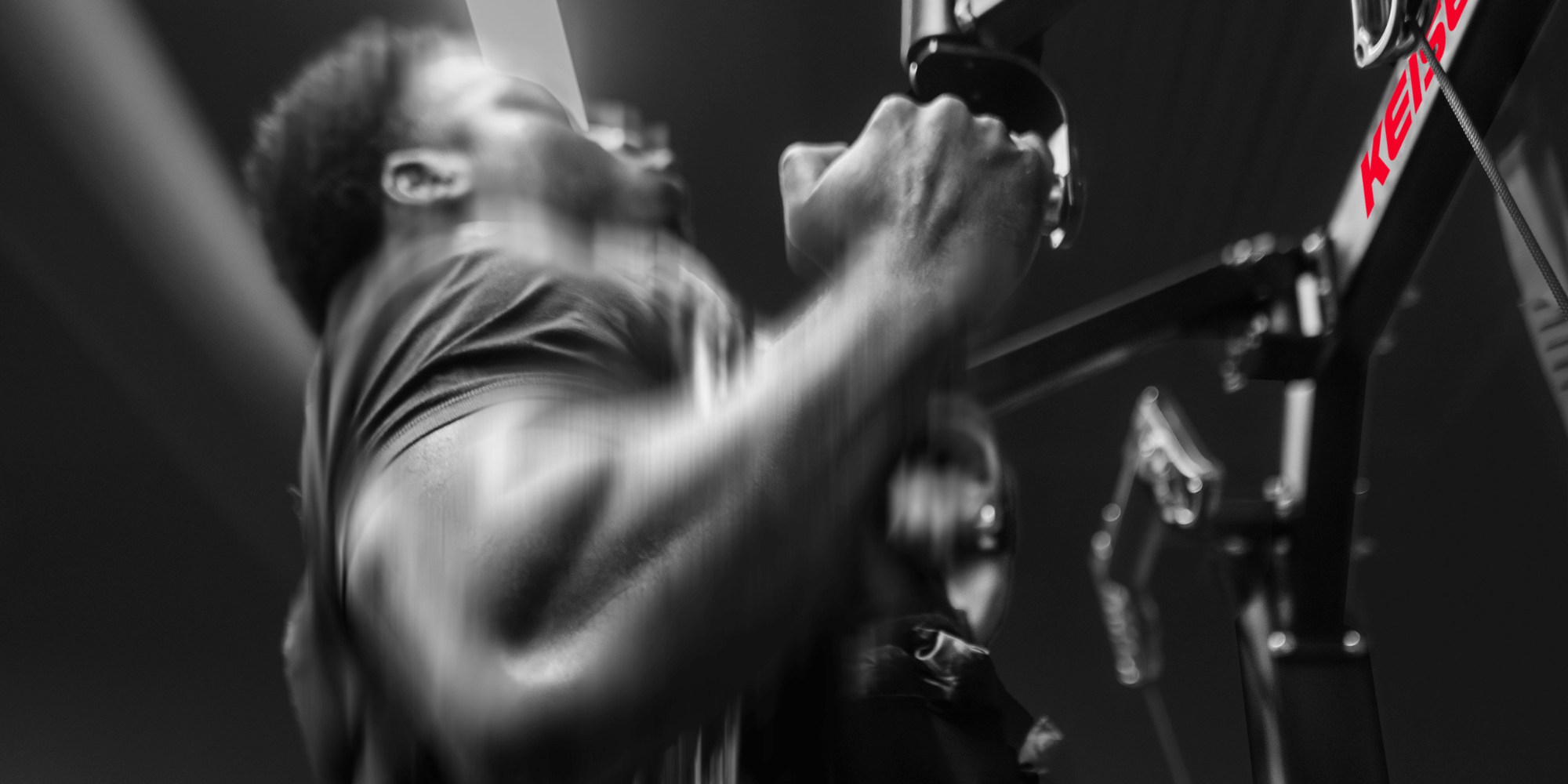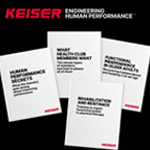5 min read

Chasing the Edge: Lessons from the NFL Combine, Exos, and Keiser
Every year, roughly 330 college players are invited to the NFL Combine. Only a fraction will be drafted, and fewer still will land in the early rounds. The margins are razor thin. A difference of 0.05 seconds in the 40-yard dash can move a player multiple rounds up the draft board.
The data is clear. From 2000–2024, results from 3,446 players show significant differences in athleticism scores between drafted and undrafted athletes. Being "good enough" in college is no longer enough: fewer than 2% of NCAA football players ever hear their name called on draft day. Athletes who rise at the Combine demonstrate speed, power, agility, and recovery at exceptional levels.
So how do they get there? Exos has refined an approach that blends science, intent, and feedback. Their use of velocity-based training, individualized power profiling, and Keiser's Pure Resistance Technology™ (PRT) offers lessons any coach can apply.

Lesson 1: Margins Are Measured in Velocity, Not Just Load
Traditional thinking often equates progress with heavier weights. Combine prep shows why that view is incomplete.
- Load–Velocity Profiling (LVP) maps how quickly athletes move light versus heavy loads. The curve identifies where power is maximized and where deficiencies exist.
- If speed falls off too quickly as load increases, programming emphasizes speed-strength. If strength lags at higher loads, adjustments push carefully into that zone.
The takeaway: peak performance depends on training the force–velocity relationship, not just adding plates. A 200-pound squat performed explosively can produce more usable power than a slow 300-pound squat.
Lesson 2: Sustaining Power Is as Important as Producing It
Combine tests rarely reward a single maximal rep. Coaches emphasize power endurance — the ability to repeat explosive effort under fatigue.
- Drop-off tracking across reps shows who can maintain velocity and power beyond the first two reps.
- Sustained output in the weight room correlates with better times and jumps on the field.
When numbers spike, we push harder. When they dip, we refine technique or emphasize recovery.
EXOS NFL COMBINE COACH
Coaches often worry that collecting more data means adding more work. In practice, velocity metrics can simplify communication rather than complicate it. Because power and velocity data appear instantly on the console, coaches don’t need post-session analysis to draw insights. A quick screenshot or weekly average can frame clear conversations: "This athlete sustained 90% velocity for more reps this week — that explains the acceleration gains you’re seeing on the field." In this way, data becomes a shared language with sport coaches and athletic trainers, not another spreadsheet to manage.
QUICK DEMO
Tracking Drop-off in Real-time
In 90 seconds, see how the A400 display captures velocity, rep-to-rep output, and drop-off. Fast setup, instant feedback.
Lesson 3: Recovery is a Performance Multiplier
The best programs do not treat recovery as downtime. They build it into performance.
- Keiser’s PRT allows athletes to move explosively without the inertia and joint stress of free weights.
- Less joint loading means lower soreness and faster recovery, which in turn enables more quality sessions per week.
- The system creates consistency: athletes show up fresh enough to repeat high-intensity efforts day after day.
The resistance feels easier on my knees and back, but I’m working harder. The next day I’m ready to go again instead of limping into practice.
EXOS NFL COMBINE ATHLETE

Lesson 4: Intent Must Be Quantified
"Move fast" is a familiar cue. But until athletes see velocity on a screen, intent is subjective.
- Real-time displays provide immediate feedback on power, velocity, and fatigue.
- Athletes respond to targets with higher engagement and urgency.
- Coaches shorten the feedback loop: when technique corrections show up instantly in the numbers, the adjustment sticks.
When the number is right in front of you, it pushes you to the next level.
EMEKA EGBUKA
Exos NFL Combine Athlete
The principle extends beyond Combine prep. Intent becomes measurable, not abstract.
Lesson 5: A Compressed Timeline Demands Precision
Combine prep operates on a fixed window — often just eight weeks. The structure matters.
- Phase 1: Adaptation — athletes establish baselines (including Keiser Optimal Power Resistance, or KOPR) and adapt to new stimuli (Keiser PRT).
- Phase 2: Velocity emphasis — training integrates speed of movement with live feedback to cue intent and reinforce technique.
- Phase 3: Peaking — volume tapers, intensity spikes, and athletes push for maximal outputs aligned with testing.
Each decision in the weight room supports a specific on-field performance marker: faster sprints, higher jumps, more efficient movement under stress.
This sequencing reinforces a central truth: in short cycles, progress must be intentional. Guesswork wastes time.
Applying Combine Lessons to Your Own Program
The NFL Combine offers a unique 8-week case study, but the principles translate well into collegiate and professional team settings. Here are five ways to adapt these insights:
1. Scale Beyond the Individual
Velocity-based profiling doesn’t require an NFL budget. Even in team environments, select key lifts — squats, presses, pulls — and establish velocity baselines. Group athletes into training zones (speed-dominant, strength-dominant, balanced) so programming scales efficiently across a roster.
2. Turn Data Into Communication
Numbers are most valuable when they inform conversations with coaches and trainers. Use velocity loss or sustained power metrics as a shared language:
- With sport coaches: "This athlete’s acceleration is improving because we’ve sustained velocity under load."
- With athletic trainers: "We’ve reduced power drop-off, which links to better fatigue resistance."
3. Prioritize Versatility in Sessions
Time and space are limited. Choose exercises that serve multiple functions and provide high-quality feedback. Pneumatic squats allow simultaneous training of force and velocity while reducing joint stress. With one station, multiple athletes can rotate in, each seeing feedback instantly. Coaches often set up stations so a small group competes side by side.
4. Understand Where Keiser Fits
Traditional iron-based lifts still have a place in many programs, particularly for building slow-tempo strength. But Keiser’s Pure Resistance Technology™ (PRT) expands what's possible by removing the limitations of mass, inertia, and momentum. This creates a more responsive, joint-friendly resistance that adapts across a wide range of speeds — not just slow, controlled lifts.
PRT is especially effective for training speed and power, where the goal is to move with intent at high velocity. Unlike traditional free weights or tethered velocity tools that only measure movement, Keiser systems provide resistance and measurement in one integrated platform — with virtually no setup or reset time between reps.
For coaches who want both — the mass of iron and the responsiveness of Keiser — Keiser Racks offer the best of both worlds. These systems combine traditional barbell training with built-in PRT, allowing athletes to train across the entire force–velocity curve without switching equipment or adding external sensors. The result: smoother transitions, more versatile sessions, and richer data — all on one rack.

5. Think Beyond Eight Weeks
While Combine prep is short and intense, the deeper value of velocity-based feedback is in shaping habits that compound over years. When athletes are taught early to move with intent and monitor power drop-off, they learn to prioritize quality over quantity. This approach builds technical consistency, reduces joint stress, and supports better recovery patterns. Over a four-year cycle, that consistency not only raises performance ceilings but also lowers injury risk — especially in soft-tissue and overuse categories. What begins as a testing advantage becomes a foundation for long-term durability and development.
3 Key Takeaways for Coaches
- Train the Force–Velocity Curve: Profile athletes to find optimal power zones. Program for their weakest point in the curve.
- Monitor Power Drop-Off, Not Just Peak: Sustained output is more predictive than a single max rep. Track drop-off to guide decisions.
- Recovery is Part of Training, Not Separate: Lower joint stress and faster recovery allow higher training quality across the week.
Final Word
The Combine shows what happens when margins matter most. But in collegiate and professional programs, these same principles create sustained advantages: athletes who not only peak for a test but maintain velocity, power, and health across seasons.
The edge is no longer about working harder. It’s about working with precision.
DATA-DRIVEN PERFORMANCE
Elevate your game with advanced training solutions. Keiser: Built for athletic performance.
Learn More

Subscribe to Keiser's FREE publications
Receive tips, articles, and tools to improve human performance via email.